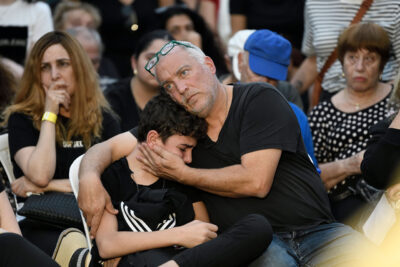No holidays to celebrate between Sukkot and Hanukkah? Don’t fret. November is here and this means it’s time to celebrate Israel History Month.
How will YOU make Israel education come alive for your students?
See below as we unpack five momentous days in modern Jewish history and how to engage your students in each of them. We hope you will join us in making this November the third annual Israel History Month.
Plus, in honor of Israel History Month, Sarah Gordon, our Senior Director of Israel Education for the Americas, shares practical advice on how to successfully implement a nuanced approach to Israel education. Read Sarah’s full piece.
This November is also the perfect time to explore “Zionism Revisited.” Use our new curriculum, including 10 just-released videos and educational resources, to uncover the different angles of Zionism and explore the people, places, and events that shaped Zionism as we know it today.
Why we created Israel History Month
As educators busy with running the day-to-day lives of our schools, camps and youth programs, we often relegate much of our Israel education to the big days: Yom Hazikaron, Yom Haatzmaut and, for some, Yom Yerushalayim.
Alternatively, some of us react to the big moments in Israeli current events, like the death of Al Jazeera reporter Shireen Abu Akleh or President Joe Biden’s visit to Israel, and that becomes the Israel education experience.
Learning about Israeli history and culture may not feel like it has the same urgency as other topics in our curriculum. So why designate a full month to teach about it?
Teaching Israeli history intermittently throughout the year can go only so far in helping our students develop both literacy and connection to the Jewish state.
Developing a generation of Jews that has only a superficial connection to this history is devastating when the story of Zionism is so remarkable and inspiring.
Russian-British social theorist Isaiah Berlin (1909-1997) said: “Israel has restored to Jews not merely personal dignity and status as human beings, but what is vastly more important, their right to choose as individuals how they shall live.”
In a pithier way, U.S. Supreme Court Justice Louis Brandeis said in 1910: “Zionism gives the Jews power to realize their dreams.”
During Israel History Month, our goal is to help ensure that our young people gain both knowledge and confidence in this extraordinary story.
We want them to care enough about this history to have opinions, and we want those opinions to be informed by literacy. The goal is not to tell our students what to think about Israeli history. It’s to give them tools for how to think about it.
Five critical events that happened in November:
Five major events happened in November that defined Israel. Below is a short summary of each of them and some key questions they raise:
- The Balfour Declaration: On November 2, 1917, British Foreign Secretary Arthur Balfour wrote a letter promising a “national home for the Jewish people” in the land of Palestine, which was ratified by the League of Nations in 1922. Why does this document carry so much significance and why was it so ambiguous?
- Yitzhak Rabin Assassination: On November 4, 1995, Rabin was assassinated. He was both a war hero and a peacemaking icon. Admired by many and reviled by some, Rabin was a real person and a complicated figure. Why does his legacy matter?
- “Zionism equals racism” U.N. resolution: Your students might know about the complicated relationship the U.N. has with Israel, but they may be surprised to discover it goes back decades. On November 10, 1975, the U.N. declared that “Zionism is racism.” Why did this concept come about, and what effect does it continue to have today, even after being repealed?
- Operation Moses: Beginning on November 21, 1984, Israel brought thousands of Ethiopian Jews to its shores in this large-scale rescue mission. This “ingathering of exiles” or “kibbutz galuyot” has been part of Israel’s raison d’etre from the beginning. What is Israel’s relationship with World Jewry? How far will Israel go to take responsibility for Jews worldwide?
- The Partition Plan: On November 29, 1947, the U.N. passed Resolution 181, or the “Partition Plan.” This plan was to divide the land into two states: one Jewish and one Arab. What led up to the resolution, and how did the Jewish and Arab communities react to it? What happened to this resolution?
How to bring Israel History Month to your classroom
Ready to bring these events to life in your classroom? Here are five simple ways to utilize our videos, podcasts and educational resources to create a multimodal learning experience with your students:
- Flip your classroom: Send video and podcast links to your students in advance. Then, utilize the questions for discussion, reflection and review, suggestions for further reading, and interactive Kahoot! quiz associated with that video or podcast.
- Host a podcast listening party: Listen to an episode of “Unpacking Israeli History” on the Balfour Declaration, the assassination of Yitzhak Rabin, the “Zionism equals racism” U.N. resolution or Operation Moses with your students. Hosting a podcast listening party is simple: Just gather your students, play the episode, listen together and discuss using the discussion questions provided.
- Play Israel History Month Bingo: After exploring the five events with your students, use this in-class Bingo game as a fun way to assess what they learned. Don’t forget to award prizes to the winners and each student!
- Create an Israel History Month display in your school hallway: Divide your class into five groups and assign each one a different event to focus on. Have each student create a collage with information, photos, drawings, artwork or poetry about their event. Students could also work together in groups to create their collages. Then, display everyone’s projects in the hallway for the rest of the month.
- Have students teach their peers about each event: Divide your class into five groups and assign each group one of the events. Ask each group to prepare a presentation on the 5 Ws (who, what, when, where, why) of their event for the rest of the class. Their presentation should include images, videos, and important facts. Each group should also create a Kahoot or other game to assess their classmates’ knowledge of what they learned.
What does nuanced education really look like?
It is now officially “acharei hachagim” (after the holidays) and schools are getting back into a routine. As students and teachers return to the classroom, November — Israel History Month — is a great time to be thinking about how schools approach teaching Israel.
While much has been written about the importance of nuanced or “commitment and critique” Israel education, there is still the question of what this approach looks like practically and how to manage the difficulties that arise when implementing it.
I will share some practical perspectives from the field, including some best practices educators can use when bringing these methods into the classroom.
- Support hesitant educators
Educators are often hesitant about implementing a more nuanced approach, out of fear that opening up complex discussions about Israel could lead students to turn away from Israel and Zionism.
A nuanced approach opens educators up to new levels of vulnerability where they may not know what to do when a student shares an opinion questioning Israel’s actions or legitimacy. Teachers may also be nervous about possible repercussions from parents and administrators.
To address these concerns, educators can learn from alumni about how these types of conversations help prepare them for encountering the “real” Israel, embracing both Israel’s strengths and flaws, which ultimately strengthens their relationship with the Jewish state.
Additionally, schools must recognize that not every teacher is comfortable leading nuanced class discussions. Many teachers would benefit from training, good mentorship, and access to a larger community of Israel educators grappling with the same issues.



